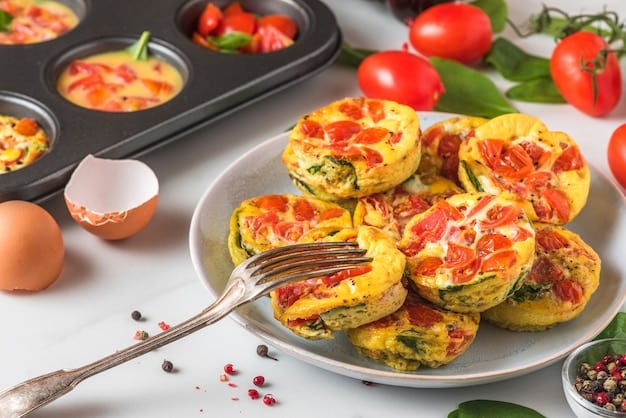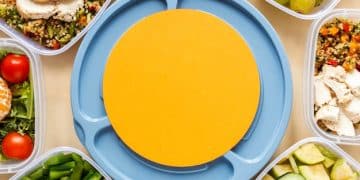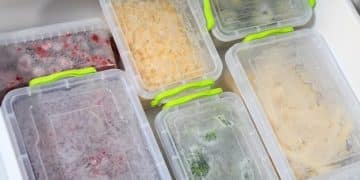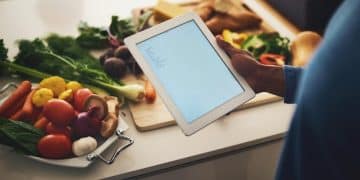Master Meal Planning: Strategically Using Leftovers to Minimize Waste

Strategically using leftovers in your meal plan is an effective way to minimize food waste, save money, and reduce meal preparation time, transforming what might be discarded into delicious and convenient meals.
Are you looking to reduce food waste and streamline your meal planning? Learning how to use leftovers strategically in your meal plan to minimize waste is a game-changer. Not only does it save you money, but it also cuts down on cooking time and helps the environment.
The Undeniable Benefits of Leftover Meal Planning
Planning meals around leftovers offers a plethora of benefits. By strategically incorporating leftovers into your meal plan, you can save time, money, and reduce food waste efficiently. Let’s dive into how this simple strategy can revolutionize your approach to meal planning.
Saving Time and Effort
One of the most significant advantages of using leftovers is the time saved. Cooking once and eating twice (or more!) reduces the number of meals you need to prepare from scratch each week. This is especially helpful on busy weeknights when time is of the essence.
Reducing Food Waste and Saving Money
Food waste is a significant issue both environmentally and economically. By planning to use leftovers, you ensure that edible food doesn’t end up in the trash. This conscious effort directly translates to savings on your grocery bill, as you maximize the use of the ingredients you purchase.

Planning with leftovers not only saves money and time but also promotes efficient kitchen management and mindful consumption.
Optimal Storage Techniques to Preserve Leftovers
Proper storage is crucial to maintaining the quality and safety of leftovers to get the most out of them. Knowing how to store food correctly can extend its life and prevent spoilage, making your meal planning efforts more effective and safe.
Cooling Down Food Quickly
The first step in proper storage is to cool down the food as quickly as possible. Bacteria thrive in temperatures between 40°F and 140°F, so getting your leftovers out of this danger zone promptly is essential. Divide large quantities into smaller containers to speed up the cooling process.
Using Airtight Containers
Airtight containers are key to preventing the growth of bacteria and keeping your leftovers fresh. These containers help to maintain the moisture levels in the food, preventing it from drying out or becoming soggy. Glass or BPA-free plastic containers are excellent choices.
- Label and Date: Always label containers with the contents and the date of preparation. This will help you keep track of what you have and ensure you use the oldest items first.
- Proper Stacking: Arrange your containers in the refrigerator so that you can easily see and access them. Keep the most perishable items in the coldest part of the fridge.
- Check Regularly: Make a habit of checking your leftovers regularly for any signs of spoilage, such as changes in color, smell, or texture.
Storing leftovers properly is a critical step in meal planning, ensuring that food remains safe and palatable for future meals.
Creative Ways to Repurpose Common Leftovers
Turning leftovers into entirely new dishes is easier than you might think. With a little creativity, you can transform last night’s dinner into today’s lunch or a completely different meal. This approach not only reduces waste but also adds variety to your diet.
Transforming Roasted Chicken
Roasted chicken is incredibly versatile. Shred it and use it in tacos, salads, or sandwiches. You can also use the carcass to make a hearty and flavorful broth for soups.
Reinventing Cooked Vegetables
Cooked vegetables can be added to omelets, frittatas, or stir-fries. They can also be pureed into sauces or dips. Roasted vegetables can be particularly flavorful when repurposed.

Repurposing leftovers is an exciting way to explore new culinary creations and optimize your resources in the kitchen. It not only reduces waste but also sparks innovation.
Integrating Leftovers into Your Weekly Meal Schedule
The cornerstone of successful meal planning with leftovers is strategically integrating them into your weekly schedule. This approach requires foresight, organization, and a bit of creativity to ensure balanced and varied meals throughout the week.
Planning for Leftover Nights
Dedicate one or two nights a week as “leftover nights.” This is when you intentionally plan to use up any remaining food in your refrigerator. You can create themed leftover nights, such as “Taco Tuesday Leftovers” or “Soup and Salad Leftovers.”
Prioritizing Perishable Items
When planning your meals, consider the perishability of the ingredients. Use more perishable items earlier in the week, and plan to use the leftovers from those meals before they spoil. This prevents waste and ensures that your food remains fresh and safe.
- Inventory Awareness: Always start your meal planning process by taking inventory of what you already have in your fridge and pantry.
- Recipe Flexibility: Choose recipes that are flexible and can easily incorporate leftover ingredients. Stir-fries, soups, and casseroles are excellent options.
- Theme Coordination: Plan a few themed meals that can utilize similar ingredients and generate complementary leftovers, making repurposing easier.
Integrating leftovers into your meal plan requires a strategic mindset and a commitment to minimizing waste. By doing so, you can create a sustainable and cost-effective approach to meal preparation.
Essential Tools and Gadgets for Leftover Meal Planning
Having the right tools and gadgets can significantly simplify your leftover meal planning process. These essential items not only help with storage but also facilitate portioning, reheating, and transforming leftovers into exciting new meals.
Quality Storage Containers
Investing in a set of high-quality, airtight storage containers is crucial. Look for containers that are stackable, easy to clean, and available in various sizes to accommodate different types of leftovers. Glass containers are an excellent choice for their durability and safety.
Food Thermometer
A food thermometer is essential for ensuring that your leftovers are reheated to a safe temperature. This helps prevent foodborne illnesses and ensures that your meals are safe to consume. Aim for an internal temperature of 165°F (74°C) when reheating leftovers.
Stocking your kitchen with the right tools is a practical step in achieving efficient leftover meal planning, ensuring both safety and quality in your meals.
Overcoming Common Challenges in Leftover Meal Planning
Even with the best intentions, leftover meal planning can present challenges. From picky eaters to time constraints, addressing these hurdles is essential for making this strategy a sustainable part of your routine. Let’s explore some common challenges and practical solutions.
Dealing with Picky Eaters
Picky eaters can be a significant obstacle to leftover meal planning. One strategy is to involve them in the planning process, allowing them to choose how leftovers are repurposed. You can also disguise leftovers by incorporating them into familiar dishes or changing the presentation.
Managing Time Constraints
Time constraints can make it challenging to incorporate leftovers into your meal plan. To overcome this, plan simple, quick meals that can easily use up leftovers. Batch cooking and freezing leftovers in individual portions can also save time on busy days.
Addressing common challenges in leftover meal planning helps transform it from a burden into a seamless, beneficial part of your daily life, enhancing both efficiency and enjoyment.
| Key Point | Brief Description |
|---|---|
| ⏰ Save Time | Reduce meal prep by reusing cooked food. |
| 💰 Save Money | Cut grocery bills by minimizing food waste. |
| 🌱 Reduce Waste | Help the environment by eating what you cook. |
| 🔄 Get Creative | Transform old dishes into new culinary delights. |
[FAQ Section]
Frequently Asked Questions
▼
Most leftovers can be safely stored in the refrigerator for 3 to 4 days. Always ensure food is properly cooled and stored in airtight containers to prevent bacterial growth.
▼
The best way to reheat leftovers is to ensure they reach an internal temperature of 165°F (74°C). Use a food thermometer to check. Microwave, oven, or stovetop methods are all viable options.
▼
Yes, you can freeze leftovers for longer storage. Properly wrapped and stored, they can last for 2 to 6 months. Thaw them in the refrigerator before reheating for best results.
▼
Involve picky eaters in the planning process, disguise leftovers in familiar dishes, or change the presentation. Making meals fun and interactive can also help.
▼
Leftover vegetables can be added to omelets, frittatas, stir-fries, or pureed into sauces and dips. Roasted vegetables, in particular, can be very flavorful when repurposed.
Conclusion
Mastering how to use leftovers strategically in meal planning to minimize waste is a pivotal step towards efficient kitchen management and sustainable eating habits. By integrating these strategies, you not only reduce food waste and save money but also foster creativity in meal preparation. Embrace the power of leftovers and transform your approach to meal planning today.





